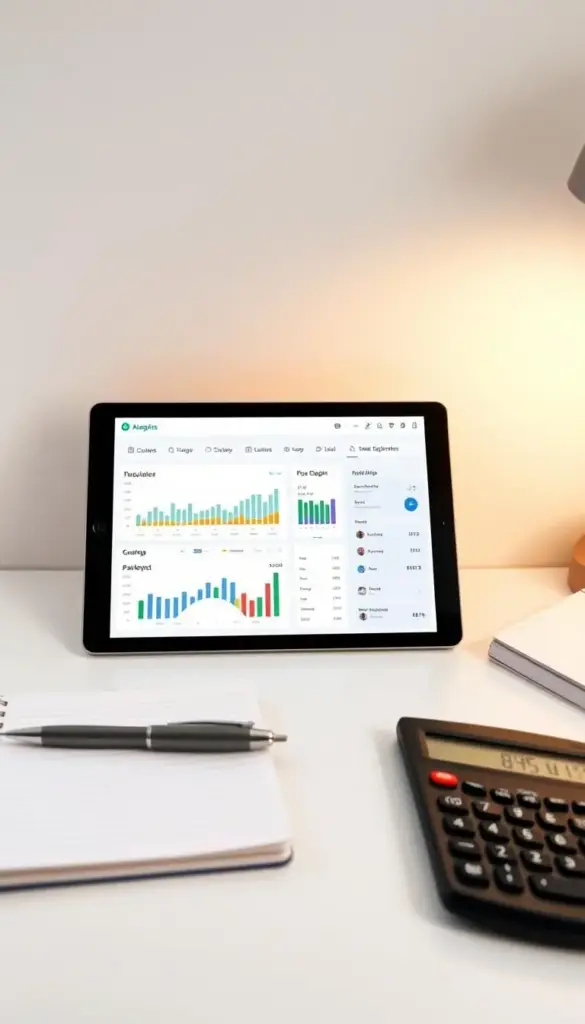Managing family finances well is key to a stress-free life. A good budgeting tool can really help. The Monthly Family Budget Planner is a great tool for families to organize their money.

This free printable for 2025 has a clear format. It helps families track their money and make smart choices. With this tool, families can manage their finances better and reach their money goals.
Key Takeaways
- Effective financial management is crucial for a stress-free life.
- The Monthly Family Budget Planner helps organize expenses, income, and savings goals.
- A clear and structured format enables families to track financial progress.
- Informed financial decisions can be made using this personal finance tool.
- Families can better manage their money and achieve financial objectives.
Make Every Dollar Count for Your Growing Family
A solid monthly budget is just the beginning of smarter family living. Pair this free planner with easy air fryer meals to slash your grocery bill, and explore affordable DIY baby toys that boost development without breaking the bank. For even more savings, don’t miss our printable baby coupon roundup.
Why Every Family Needs a Budget Planner in 2025
As we enter 2025, managing family money is more important than ever. With rising living costs and economic uncertainty, a good budgeting tool can help a lot. It can help families stay financially stable.
Economic Challenges Facing American Families
American families face many economic challenges, like inflation and unexpected bills. A recent survey showed many families struggle to make ends meet. This highlights the need for good financial planning software.
The current economic situation means families need to watch their spending and save more. A budget planner helps track expenses and find ways to save money.
| Economic Challenge | Impact on Families | Budgeting Solution |
|---|---|---|
| Inflation | Reduced purchasing power | Adjust spending habits |
| Unexpected Expenses | Financial stress | Create emergency funds |
Benefits of Organized Financial Planning
Organized financial planning has many benefits, like less financial stress and better savings. Using a budgeting tool helps families plan their spending and make smart financial choices.
“A budget is telling your money where to go instead of wondering where it went.” – Dave Ramsey
Using a budget planner can lead to long-term financial stability and security. It’s about setting up a system that works for your family and sticking to it.

Understanding the Basics of Family Budgeting
To find financial peace, it’s key to understand family budgeting basics. Budgeting is more than just tracking money. It’s about making smart financial choices that match your family’s goals and values.
Income vs. Expenses: The Foundation of Budgeting
The heart of any budget is knowing the balance between what you earn and what you spend. You need to track all your income and sort out your expenses. This way, you make sure you don’t spend more than you make. A budget tracker can make this easier by showing you your financial state clearly.

Fixed vs. Variable Expenses
It’s important to know the difference between fixed and variable expenses. Fixed costs, like rent or mortgage, stay the same. But variable costs, like entertainment or food, can change. Knowing this helps you adjust your spending to stay on budget.
Setting Realistic Financial Goals
Setting reachable financial goals is a big part of budgeting. Goals can be saving for a trip, a new car, or your kids’ education. Having clear goals helps you decide how to spend and save. A financial organizer can help you keep track of your progress.
By understanding these basics, families can make a budget that’s both detailed and realistic. This leads to financial stability and peace of mind.
Common Budgeting Mistakes Families Make
Families often make big budgeting mistakes. These can be avoided with the right tools and advice. A good budget helps track spending and reach financial goals.
Underestimating Regular Expenses
One big mistake is underestimating regular costs. This leads to not enough money in the budget. A good expense tracker helps keep track of things like bills, food, and travel.
Forgetting Seasonal and Annual Costs
Families often forget about yearly and seasonal costs. This includes holiday spending, insurance, and property taxes. Adding these to the budget helps stay financially ready all year.
Not Planning for Emergencies
Not planning for emergencies can mess up even the best budgets. Having an emergency fund is key for unexpected costs. It keeps finances stable and gives peace of mind.
By avoiding these mistakes and using a good budget management tool, families can do better financially.
The Ultimate Budget Planner for Family Financial Success
Financial stability is crucial for families. A good budget planner is essential for achieving it. Our 2025 template helps families manage their finances effectively, offering a clear path to financial success.
Why Our 2025 Template Stands Out
Our 2025 template is made for modern families. It has special features like inflation adjustment tools and detailed expense categories. This ensures families can track their money accurately.
Designed for Modern Family Finances
The template is flexible and meets the varied needs of families. It handles different incomes and seasonal costs well. It gives families the tools to manage their finances effectively.
Balancing Simplicity and Comprehensiveness
Finding the right balance in a budget planner is key. Our template is easy to use but still captures all the financial details. It’s designed to be both simple and comprehensive.
Using our budget planner, families can make smart financial choices. This leads to reaching their long-term financial goals. The 2025 template is a vital tool for family financial success, thanks to its user-friendly design and powerful features.
Features of Our Free 2025 Printable Template
Our 2025 printable family budget template makes financial planning easy for families. It has a simple design and lots of features to help manage your money well.
User-Friendly Design for All Family Members
The template is easy to use, so everyone in the family can help with budgeting. It has clear sections and simple categories. This makes it easy for everyone to contribute to planning your finances.
Comprehensive Expense Categories
Our template covers many expense categories, like groceries, utilities, entertainment, and savings. This way, you can track all your family’s spending.
Goal Tracking and Progress Visualization
With our template, you can track your financial goals and see how you’re doing. It helps you keep an eye on your savings, debt, and other financial targets. This keeps you motivated and on track.
New 2025 Inflation Adjustment Tools
The 2025 template also has tools to adjust for inflation. These tools help you keep up with rising costs and adjust your budget. This way, you can maintain your spending power.
Our 2025 printable template offers a strong solution for family financial planning. It helps you manage daily expenses and plan for the future. This template keeps you organized and in control.
How to Download and Set Up Your Free Template
Starting with our free family budget planner is easy. It lets you organize your money right away. Just follow these simple steps to download, print, and set up your budget planner.
Digital Download Instructions
To download the template, click the provided link. The file will save to your device. Make sure you have a PDF reader to open it.
Printing Recommendations
For the best print, use high-quality paper. This makes the budget planner easy to read and last longer.
- Choose high-quality paper or cardstock for printing.
- Set your printer to the best quality.
- Print it in a size that’s easy for you to read.
Initial Setup Guide
After printing, take a few minutes to look over the template. Get to know its sections. This will help you use the budget planner to manage your family’s money well.
- Look over the different sections of the budget planner.
- Learn how to put in your financial data.
- Start tracking your income and expenses.
Step-by-Step Guide to Implementing Your Family Budget
Starting a family budget is about knowing your money situation. By using a clear plan, you can make a budget that fits your family.
Gathering Your Financial Information
The first step is to collect all your financial details. This includes:
- Bank statements
- Pay stubs
- Receipts for regular expenses
- Any other financial documents
Having this info helps you understand your financial health.
Inputting Income Sources
Next, list all your income sources in your budget tool. This includes:
| Income Source | Monthly Amount |
|---|---|
| Primary Income | $4,000 |
| Secondary Income | $1,000 |
| Total Income | $5,000 |
This shows your total monthly income clearly.
Categorizing and Estimating Expenses
Sort your expenses into fixed (like rent) and variable (like food) costs. Use your expense tracker to guess how much you’ll spend each month in each category.
For example, you might spend 30% of your income on housing and utilities.
Setting Savings Goals
Lastly, decide on your savings goals. Whether it’s for an emergency fund or a big purchase, clear goals help you stay focused.
By following these steps and using a budget tool, you can make a detailed family budget. This will help you reach financial stability.
Customizing Your Budget Planner for Your Family’s Unique Needs
To manage your family’s money well, your budget planner needs to fit your family’s needs. It’s important to make it your own. This way, it will show your family’s income, expenses, and savings goals accurately.
Adjusting Categories for Different Family Structures
Every family is different, and so are their budgets. For example, a single-parent family might spend differently than a family with two parents and kids. By changing your budget planner to match your family, you can track expenses like childcare and education better.
- Find the main expense categories that fit your family.
- Change these categories to include specific costs, like childcare or eldercare.
- Keep checking and updating these categories as your family’s needs change.
Accommodating Variable Income
For families with income that changes, like freelancers, budgeting is a bit tricky. Your budget planner should handle income changes well. This helps you manage when money is tight and take advantage of good times.
“The key to managing variable income is not just to budget for the average month but to plan for the worst-case scenario and capitalize on the best-case opportunities.”
To deal with variable income, think about:
- Having a safety net for low-income months.
- Saving extra money when you earn more.
- Adjusting your spending based on how much you expect to make.
Planning for Children’s Expenses
Expenses for kids can include everyday things, school, and activities outside of school. Your budget planner should have sections for these costs. This way, you’re ready for both regular and unexpected expenses of raising kids.
| Expense Category | Monthly Cost | Annual Cost |
|---|---|---|
| Childcare | $500 | $6,000 |
| Education | $200 | $2,400 |
| Extracurricular Activities | $100 | $1,200 |
By making your budget planner fit your family’s needs, you can manage your money better. This helps you reach your financial goals.
Seasonal Budgeting: Planning for Holidays and Special Events
As the year goes on, families face many seasonal costs. These can upset their budget if not planned for. Seasonal budgeting helps you get ready for these costs. This way, holidays, back-to-school, and other events won’t mess up your money plans.
Creating Sinking Funds for Annual Expenses
One smart way to handle seasonal costs is to use sinking funds. A sinking fund is a special savings spot in your budget. It builds up money over time for big, expected costs. For example, save a bit each month for holiday expenses to be ready when it’s time to celebrate.
- Find out what annual costs you have, like holiday gifts or summer camps.
- Figure out how much you spend on these things each year.
- Split this yearly total by 12 to find out how much to save each month.
Holiday Budget Planning
Holiday budgeting is more than just saving for presents. It’s about planning for the whole holiday, including travel, decorations, and fun. By making a detailed holiday budget, you can enjoy the season without worrying about money.
- Make a list of all holiday expenses.
- Set a budget for each area.
- Keep track of how much you spend during the holidays.
Managing Back-to-School and Other Seasonal Costs
Back-to-school, seasonal upkeep, and other regular costs need planning too. By getting ready for these expenses and saving for them, you can handle them without hurting your budget.
To manage these costs well, think about using a budgeting tool or financial planning software. These tools help you keep track of your spending and savings goals all year. This way, you’re always ready for the financial ups and downs of family life.
Monthly Budget Review: Making Adjustments That Work
Reviewing your family budget monthly is key to financial stability. It helps you stay on track with your long-term goals. By checking your spending, income, and savings each month, you make smart choices.
This process highlights where you can save money. It also celebrates your financial wins.
Setting a Regular Review Schedule
Make budget reviews a regular habit. Choose a time each month, like when your bank statements arrive. This consistency helps you stay focused on your financial goals.
Use a budget tracker or financial organizer to keep track.
Analyzing Spending Patterns
Sorting your expenses into categories shows spending trends. Do you spend too much in some areas? Can you cut back without hurting your lifestyle? Understanding these patterns leads to better financial choices.
Making Adjustments Based on Results
After spotting areas for improvement, it’s time to act. You might adjust your budget, reduce non-essential spending, or boost your income. The aim is to align your spending with your budget, ensuring you reach your financial goals.
Teaching Children About Money Using Your Budget Planner
Teaching kids about money with a budget planner is a smart move. It helps them learn about personal finance early on. This way, they understand money’s value and how to handle it wisely.
Age-Appropriate Financial Education
Teaching kids about money should match their age and level of understanding. Young ones can start with simple ideas like saving coins. As they get older, they can learn about budgeting for needs and wants.
- For young children: Saving money in a piggy bank
- For pre-teens: Understanding needs vs. wants
- For teenagers: Budgeting for personal expenses
Including Children in Budget Discussions
Getting kids involved in budget talks is key. It helps them grasp financial management better. It’s a chance to explain why certain financial choices are made and to involve them in budgeting.
When talking about the family budget, remember to:
- Explain the purpose of budgeting
- Discuss income and expenses
- Set financial goals together
Creating Mini-Budgets for Kids
Mini-budgets for kids are a great way to teach them about money. They can help manage their own money for allowances, savings, and expenses. It’s a real-life lesson in budgeting.
By teaching kids with a budget planner, parents equip them with vital financial skills. These skills will serve them well for the rest of their lives.
How to Use a Budget Planner
Using a budget planner is a straightforward process that can help you manage your finances effectively. Here’s a step-by-step guide on how to use a budget planner:
- Start by gathering all your financial documents: Collect your income statements, expense reports, and any other relevant financial information. This will help you accurately track your income and expenses.
- Set financial goals: Determine what you want to achieve with your budget. Whether it’s saving for a down payment on a house, paying off debt, or building an emergency fund, having clear goals will help you stay focused.
- Track your income: Record all your sources of income, including your salary, investments, and any side hustles. This will give you a clear picture of your financial resources.
- Track your expenses: Keep a record of every expense, no matter how small. This includes groceries, transportation, entertainment, and any other expenses. By tracking your expenses, you can identify areas where you can cut back and allocate funds to your goals.
- Allocate funds to different categories: Based on your financial goals and expenses, allocate funds to different categories such as housing, transportation, food, entertainment, and savings. This will help you prioritize your spending and ensure that you’re meeting your financial objectives.
- Regularly review and adjust your budget: Budgeting is not a one-time task; it requires ongoing monitoring and adjustments. Regularly review your budget to ensure that you’re on track to meet your financial goals. Make any necessary adjustments to stay on course.
By following these steps, you can effectively use a budget planner to manage your finances, achieve your financial goals, and gain a better understanding of your spending habits.
Benefits of Using a Budget Planner
Using a budget planner offers several benefits:
- Improved financial management: A budget planner helps you track your income and expenses, allowing you to make informed financial decisions and avoid overspending.
- Increased savings: By allocating funds to savings goals, you can work towards building an emergency fund, paying off debt, or saving for long-term goals.
- Reduced financial stress: Having a clear understanding of your financial situation and staying on top of your expenses can help alleviate financial stress and anxiety.
- Enhanced financial discipline: Using a budget planner promotes financial discipline by helping you prioritize your spending and make conscious financial decisions.
By incorporating a budget planner into your financial routine, you can take control of your finances, achieve your financial goals, and enjoy peace of mind.






